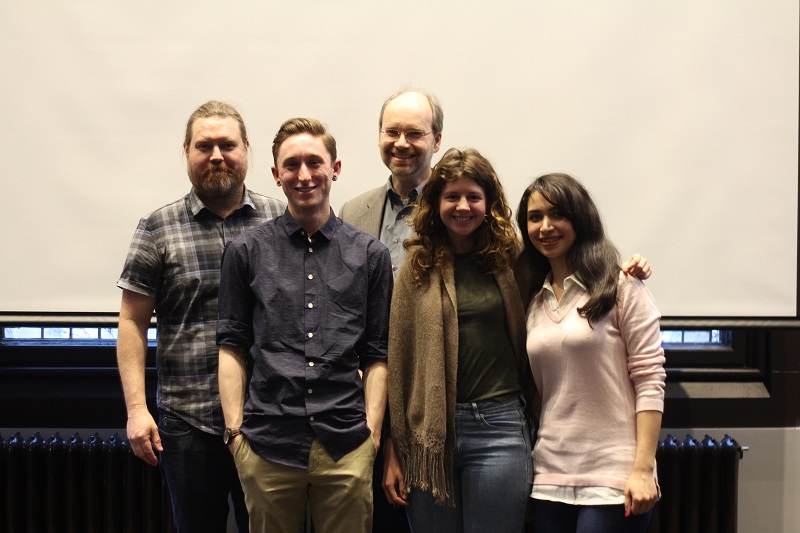From left: John Cole, Benjamin Brunen, Jochen Jaeger, Ariel Spanovicz and Mehrdokht Pourali. Feature photo by Sandra Hercegova.
The second annual Sustainability Across Disciplines Conference invited students to learn and participate
Concordia united professors, graduate and undergraduate students from various fields of study to discuss sustainability for the second annual Sustainability Across Disciplines Conference. The conference took place on March 8 and 9, and offered students the opportunity to present their sustainability research to an audience. At the “Landscape Ecology Perspectives on Sustainability” panel, four Concordia students presented their research theses.
***
The first presenter was Ariel Spanovicz, a science and environmental geography graduate who will be pursuing her master’s in environmental science at ETH Zurich University. She presented her research project on the impacts of road kill. “Road ecology is so exciting because it’s such a new field and we know so little about it, and so many people aren’t doing anything about it,” Spanovicz said. “We know about habitat fragmentation, but do we know how much the roads are impacting all of this?”
During her presentation, Spanovicz focused on mortality rates of road kill by comparing data collected from one road in Quebec with two roads in Brazil. “We combined to see the variations and to see if we can find any differences and similarities,” she explained.
According to Spanovicz, this project started when she graduated and completed her honours thesis with Jochen Jaeger, an associate professor and the graduate program director of the geography, planning and environment program. Jaeger offered Spanovicz the opportunity to work with road kill data from roads in Quebec, and Spanovicz decided to embark on this research journey. “It started off as a very small project. We were just going to do a hot-spot analysis with this data. [The project] just grew and grew, and now it’s been over a year,” Spanovicz said. She has been working alongside Jaeger and Fernanda Zimmermann Teixeira, who lives in Brazil. Zimmermann Teixeira had road kill data from two roads in Brazil and came to Montreal to meet Spanovicz for this project. Spanovicz said she wants to find a way to work with nature—not against it. “If anyone is going to fight, it’s going to be me because I care,” she said. “I think we’ve had some really positive outlooks, just even in the past decade or so.”
***
Benjamin Brunen followed with his thesis on landscape ecology. He focused on analyzing the effects of a high-traffic highway on wildlife movement in proposed ecological corridors. Brunen is a master’s student in science and geography. According to him, human infrastructure is rapidly expanding, therefore it’s even more important to preserve natural habitats. “I really care about the environment and nature,” Brunen said. “I like helping [nature and animals] to not be as negatively impacted by human activity. […] There are ways to mitigate the negative effects.”
During his presentation, Brunen touched upon the effects of roads on wildlife, habitat fragmentation and the subsequent decrease in animal movement, local extinction and genetic loss. He also presented mitigation measures, such as wildlife passages and exclusion fencing.
“My journey is going to be living in my lab and doing field work constantly for the next year,” Brunen said. “I’m really looking forward to that; working in science is just exciting. The work is always worth it, and in my case, it might actually help out.”
***
Next, John Cole presented his thesis proposal on the past, present and future land use in the Adirondacks. According to Cole, there has not yet been research or work published on the Adirondack and Laurentian areas. Therefore, the Nature Conservancy of Canada has funded Cole for two years to do analysis in the area.
“It’s a really exciting time for conservation in the Montreal area because the Quebec government is supporting work on connectivity,” he said. “They all understand that it is vital to preserve large, intact and resilient ecosystems to combat climate change to create a sustainable future.”
In Cole’s presentation, he divided the research behind his thesis into three chapters. The first chapter compared the past and present by looking back 40 years to see how the landscape has changed because of human development. In the second chapter, Cole discussed the present and future. “I am examining the effects of continued development of the landscape 20 to 40 years in the future,” he explained. The last chapter focused on proactive road mitigation measures for the present and future. “I will look more closely at the road network as a barrier to animal movement and a high mortality risk,” Cole said.
***
Another student in geography and environmental studies, Mehrdokht Pourali, addressed the condition of urban sprawl. Her thesis research focused on addressing the consequences and drivers of urban sprawl. According to Pourali, there is not a singular definition of urban sprawl, however, she has decided to define it in a basic and objective way. “It’s a diverse, low-density, low-diversity development which is ultimately unsustainable at the expense of high-quality agriculture land and natural areas,” Pourali explained.
She also explained how urban sprawl has detrimental effects on the environment because of increased energy consumption, increased water pollution and water consumption, reduced farmland or natural habitats, increased traffic congestion and increased cost of infrastructure.
“The loss of wildland, the loss of agricultural land to urban sprawl is not only the loss of the fresh food sources but also the loss of habitat,” Pourali said. She also discussed the causes of urban sprawl, which are mainly demographic, socio-economic, political and technological.
All the presentations showcased new knowledge concerning sustainability in our world today. According to Spanovicz, there is still hope for a sustainable future. “You have to hold on to those little hopes and little things to push you through,” she said. “It’s just a matter of giving up or not. People get involved the more they hear about this.”




